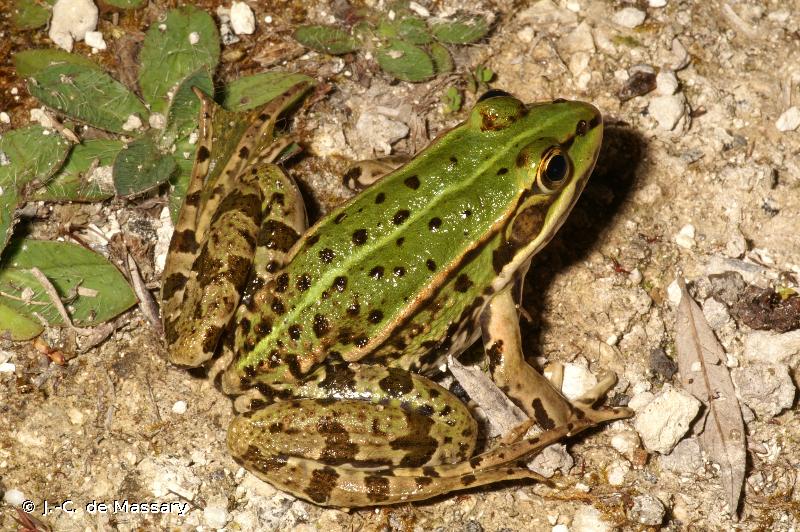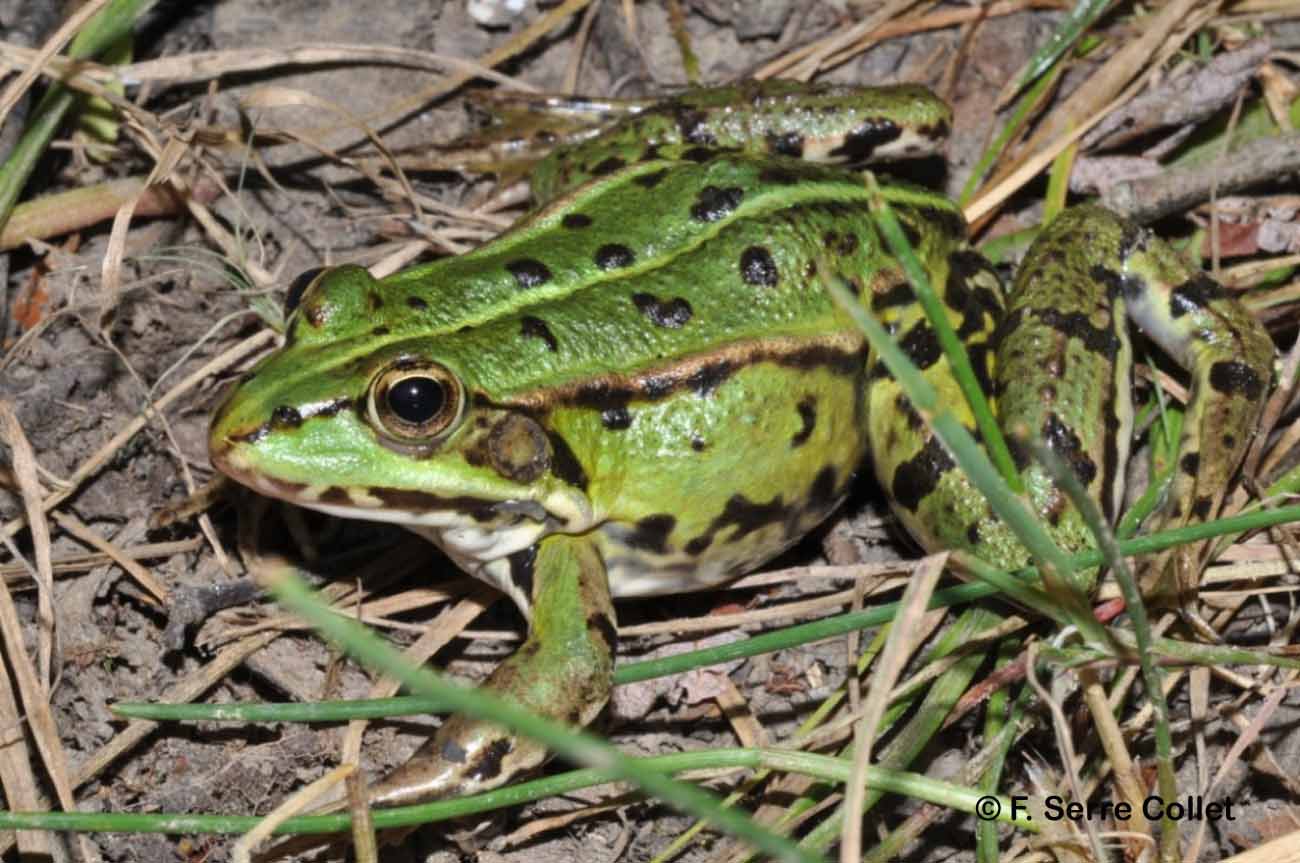
Pelophylax kl. esculentus Grenouille verte, femelle et mâl… Flickr
Description: Pelophylax esculentus is the fertile hybrid of the Pool Frog (Pelophylax lessonae) and the Marsh Frog (Pelophylax ridibundus), hence the addition of the "kl." (for klepton or synklepton) in the species name. During the ice ages] the population of the common ancestor of both species was split into two.

Pelophylax kl. esculentus or Pelophylax lessonae ? Flickr
esculentus (Pelophylax lessonae x Pelophylax ridibundus), and on p. 115 an account for another hybridogenetic associate, Pelophylax kl. grafi (Pelophylax perezi x Pelophylax ridibundus). Ermakov, Ivanov, Titov, Svinin, and Litvinchuk, 2019, Russ. J. Herpetol., 26: 367-370, reported on a multiplex PCR method for identifying Pelophylax.

Grenouille verte Pelophylax kl. esculentus Clicnat Picardie Nature
The edible frog ( Pelophylax kl. esculentus) is a name for a common European frog, also known as the common water frog or green frog (however, this latter term is also used for the North American species Rana clamitans ). More Info
Pelophylax kl. esculentus
Pelophylax esculentus does not represent a "real" biological species but a hybridogenetic klepton (therefore also written "Pelophylax kl. esculentus / Rana kl. esculenta") as a result of hybridization between the parental taxa Pelophylax lessonae ( Rana lessonae) and Pelophylax ridibundus ( Rana ridibunda)

Pelophylax kl. esculentus (Linnaeus, 1758) Grenouille verte (La
Pelophylax kl. esculentus The edible frog ( Pelophylax kl. esculentus ) is a species of common European frog, also known as the common water frog or green frog (however, this latter term is also used for the North American species Rana clamitans ). Te Terrestrial No Not a migrant E starts with Photos with Edible frog

Pelophylax kl. esculentus Gregor Seidlhofer Flickr
Both testosterone and dihydrotestosterone increase in treefrogs after hearing calls regardless of whether or not the listener calls back, and males hearing tones have no elevation in androgens whether or not they themselves call.

Photo Grenouille verte Pelophylax kl. esculentus Observations.be
Abstract Central European water frog Pelophylax esculentus is a hybrid that lives sympatrically and forms genetic systems with one of its parental species, in this case L-E (P. lessonae - P. esculentus). Hybrids are restored in each generation due to hybridogenesis, a unique mode of hemiclonal reproduction. We investigated changes in the species composition, mate choice, and genome.

Pelophylax kl. esculentus (Edible Frog, Common Water Frog,… Flickr
The edible frog Pelophylax kl. esculentus is a hybridogenetic hybrid of the pool frog Pelophylax lessonae and the marsh frog P. ridibundus. Its populations are maintained however through other crossings by hybridogenesis. [5] References ^ a b IUCN SSC Amphibian Specialist Group. (2022).
Fotografia przyrody. Żaba wodna (Pelophylax kl. esculentus, syn. Rana
The Italian edible frog ( Pelophylax kl. hispanicus) is a hybridogenic species in the true frog family Ranidae. These frogs are the offspring of P. bergeri and either P. ridibundus or the edible frog ( P. kl. esculentus) which is itself of hybrid origin. It is endemic to Italy; despite the specific name hispanicus ( Latin for "the Spanish one.

Pelophylax kl. esculentus (Linnaeus, 1758) Grenouille verte (La
Pelophylax kl. esculentus Even the scientific name hints at why this species is so interesting to humans: "esculentus", meaning "edible". The Edible Frog was formerly found in huge numbers in lakes and streams and was considered a delectable treat.

Pelophylax kl. esculentus (grenouille verte)
In hybridogenetic water frogs, the hybrid Pelophylax kl. esculentus (genomes RL) usually eliminates one genome from its germline and relies on its parental species P. lessonae (genomes LL) or P. ridibundus (genomes RR) to perpetuate in so-called L-E and R-E systems.

Pelophylax kl. esculentus (Linnaeus, 1758) Grenouille commune
Pelophylax kl. esculentus Read our Complete Guide to Classification of Animals. Edible Frog Conservation Status Least Concern Edible Frog Locations Europe Edible Frog Facts Prey Insects, Moths, Spiders Name Of Young Tadpole Group Behavior

Frog (Pelophylax kl. esculentus) During a hike in the midd… Flickr
2.1 Preparation of P. kl. Esculentus Skin Secretion. Pelophylax kl. esculentus (n = 30) obtained from a local herpetological supplier were all adults and secretion harvesting was performed in the field after which frogs were released.Gentle transdermal electrical stimulation (5 V; 3 ms pulses) for 30 s was employed to collect skin secretions from the frog's dorsal skin.

Teichfrosch Pelophylax kl. esculentus, Pelophylax „esculen… Flickr
Rana esculenta Müller, 1882. Rana ridibunda Marx, 1968. Rana levantina Schneider, Sinsch, and Nevo, 1992. Rana ( Pelophylax) bedriagae Dubois, 1992. Type specimen: Syntypes MZUT (Museo di Zoologia, Instituto di Zoologia e Anatomia Comparata Universitá di Torino, Torino). Type locality: "Damas" (Damascus, Syria).

Pelophylax kl. esculentus BHHUTRA
Pelophylax is a genus of true frogs widespread in Eurasia, with a few species ranging into northern Africa. This genus was erected by Leopold Fitzinger in 1843 to accommodate the green frogs of the Old World, which he considered distinct from the brown pond frogs of Carl Linnaeus ' genus Rana .

Résultat de recherche d'images pour "Pelophylax kl. esculentus" Лягушка
The edible frog ( Pelophylax kl. esculentus) [1] [2] is a species of common European frog, also known as the common water frog or green frog (however, this latter term is also used for the North American species Rana clamitans ). It is used for food, particularly in France for the delicacy frog legs.